Growing majority of Australians believe AI creates more problems than it solves

New research from Roy Morgan reveals Australians are increasingly concerned about artificial intelligence (AI), with 65% (up 8% points since 2023) believing that “overall, artificial intelligence (AI) creates more problems than it solves” compared to 35% (down 8% points) who say it “solves more problems than it creates”.
One in four (25%) Australians believe AI presents a risk of human extinction in the next twenty years, up from 20% in 2023.
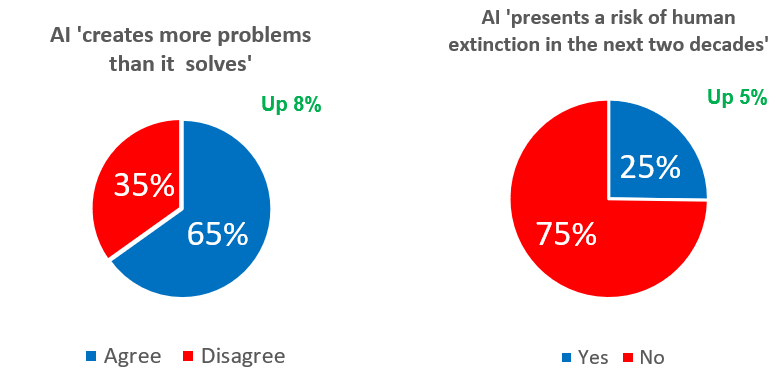
Source: Roy Morgan Snap SMS Survey: October 2-4, 2025. Base: Australians 18+, n= 3,543. Weighted results.
Same trend as 2023, women, older Australians, and regional Australians are more sceptical of AI
Women are more sceptical about AI than men, with 69% of women compared to 61% of men believing that overall, artificial intelligence (AI) creates more problems than it solves.
By age, Australians aged 35–49 are the least sceptical, with 62% saying AI creates more problems, while older Australians aged 65+ are the most sceptical at 68%.
Australians living in urban areas (63%) are less sceptical than those in regional areas (69%).
Across the states, scepticism is strongest in South Australia (73%) and Tasmania (71%), compared with New South Wales (63%) and Victoria (64%). Queensland (66%) and Western Australia (66%) align closely with the national average of 65% who believe AI creates more problems than it solves.
Personal perspective: slightly more positive, but scepticism still dominates
When asked from a personal viewpoint, “For you personally, do you agree or disagree that artificial intelligence (AI) solves more problems than it creates?”, Australians remain largely sceptical, though concern eases slightly. Nationally, the share saying AI creates more problems than it solves falls from 65% to 61%, reflecting a modest softening of attitudes.
Men show the largest improvement, with scepticism dropping from 61% to 55%, while women fall from 69% to 66%. By age, the strongest decline is among 35–49 year-olds, down 7% points to 55%, while other age groups record smaller falls of two to four points.
The rural–urban gap also narrows: in country areas, scepticism dips from 69% to 65%, and in urban areas from 63% to 59%.
Across the states, attitudes improve most in Victoria (down eight points to 56%), South Australia (down nine to 64%) and Tasmania (down nine to 62%), while Queensland (63%), Western Australia (62%) and New South Wales (62%) show smaller shifts.
Overall, viewing the question personally softens opinions, especially among men, middle-aged Australians and residents of Victoria, South Australia and Tasmania. However, a clear majority of 61% still believe AI creates more problems than it solves for them personally.
% of Australians who agree for them personally AI “solves more problems than it creates” (vs disagree = “creates more problems than it solves”), by sex, age and urban vs rural
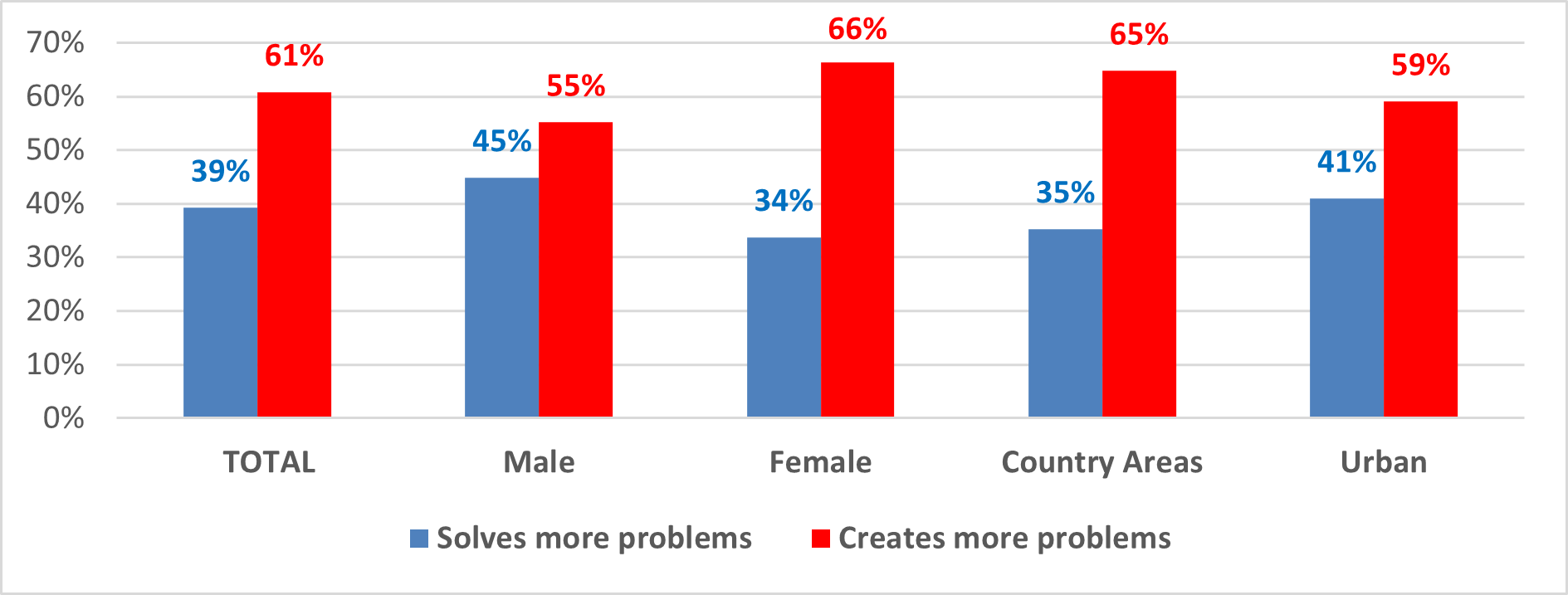
Source: Roy Morgan Snap SMS Survey: October 2-4, 2025. Base: Australians 18+, n= 1,413. Weighted results.
One in four believe AI presents a risk of human extinction in the next two decades
When asked, “Do you believe artificial intelligence (AI) presents a risk of human extinction in the next two decades?”, 25% of Australians said yes, and 75% said no, a 5% point increase in concern since 2023, when 20% said yes and 80% said no.
Men (26%) and women (24%) hold similar views. Concern is highest among 25–34-year-olds (32%), followed by 35–49 (26%), 50–64 (25%), 18–24 (22%) and 65+ (21%).
Australians in country areas are more likely to say ‘yes’ than those in urban centres (28% vs 24%). By State, concern is led by South Australia (30%), followed by New South Wales (27%), Queensland (26%), Western Australia (23%), Victoria (22%) and Tasmania (15%).
What Australians are saying:
Australians were asked two open-ended questions to explain why they feel the way they do about artificial intelligence (AI).
Respondents answered both statements and their inverses:
- “What makes you agree or disagree that overall, AI solves more problems than it creates?”
- “What makes you agree or disagree that, for you personally, AI solves more problems than it creates?”
Their responses reveal in their own words what’s driving optimism and concern, from productivity and learning to misinformation, job threats and loss of human creativity.
Australians who say AI solves more problems highlight productivity, learning and medical progress
1. Productivity & Time-Saving (23%)
Australians overwhelmingly describe AI as a way to make life and work more efficient, automating repetitive tasks, speeding research and freeing people for higher-value work.
- “It saves me hours of research.”
- “AI helps me summarise and spot discrepancies that would take me hours otherwise.”
- “Makes mundane tasks easier and lets humans focus on creative thinking.”
2. AI as a Neutral Tool / Human Responsibility (20%)
A major group insists the technology itself isn’t the problem, people are. They describe AI as neutral, emotionless and only as ethical as those who use it.
- “AI doesn’t create problems. People do.”
- “It’s a tool the output depends on the user.”
- “Like any technology, it’s only dangerous if misused.”
3. Access to Knowledge & Learning (15%)
Respondents celebrate AI’s ability to democratise information, helping ordinary people learn, plan and make informed decisions.
- “It allows people to access information and form calculated decisions.”
- “AI helps break down complex topics and barriers to education.”
- “It gives everyday people expert-level knowledge instantly.”
4. Medical & Scientific Advancement (12%)
Health and science are cited as clear proof of AI’s benefit, with optimism about faster discoveries and earlier disease detection.
- “Advancements in the medical field are already life-saving.”
- “AI found a brain region involved in epilepsy , children were cured.”
- “Its capacity for research will bring forward decades of discoveries.”
5. Regulation, Governance & Control (7%)
Even supporters stress that oversight matters. Many want policies to guide development and protect against misuse.
- “AI in moderation and with the right policies is beneficial.”
- “It needs to be regulated so it’s used properly.”
- “Control of this is critical for everyone’s future.”
Top 5 reasons Australians gave when asked: “What makes you agree that artificial intelligence (AI) solves more problems than it creates?”

Source: Roy Morgan Snap SMS Survey: October 2-4, 2025. Base: Australians 18+, n= 2,568 total open ended responses.
Australians who say AI creates more problems point to lost thinking skills, inaccuracy and environmental harm
1. Loss of Critical Thinking & Creativity (20%)
Many Australians fear AI weakens independent thought, creativity and learning, especially among young people who may rely on it to think for them.
- “AI decreases the need for critical thinking, reasoning and research. It will make people lazy.”
- “It takes away real learning opportunities for children and young adults.”
- “Making processes faster is not always better, we risk losing human creativity.”
2. Accuracy & ‘Hallucinations’ (19%)
Respondents repeatedly describe AI as unreliable, confident but wrong, and warn that users trust false information without checking.
- “AI can provide incorrect information and needs to be double-checked by a human.”
- “It makes things up according to historical data, so it’s often incorrect.”
- “People take what AI says on blind faith, even when it’s wrong.”
3. Environmental Impact (Energy, Water, Waste) (18%)
Environmental harm is a growing worry: Australians cite the power, water and emissions burden of vast data centres.
- “Artificial intelligence is extremely resource-intensive it’s killing our planet.”
- “AI ruins the earth and independent thinking in return for convenience.”
- “The water consumption of AI is abhorrent, that problem should be solved first.”
4. Misinformation & Deepfakes (17%)
Many distrust AI for blurring truth and fabrication, spreading scams, and making it impossible to tell what’s real online.
- “AI content farms push garbage online, you can’t tell if you’re talking to a real person.”
- “It’s used to create fake photos and videos; some very scary things can be done.”
- “I have to stop and ask if something is real or AI, we’ll be easily misled.”
5. Job Loss & Economic Displacement (14%)
Many link AI to job insecurity, warning that automation is replacing people across creative, service and administrative roles.
- “AI is already causing job losses, just look at the banks.”
- “Anything that tries to replace people creates problems.”
- “It will take away creative and entry-level jobs that people depend on.”
Top 5 reasons when asked: What makes you agree that AI creates more problems than it solves?”
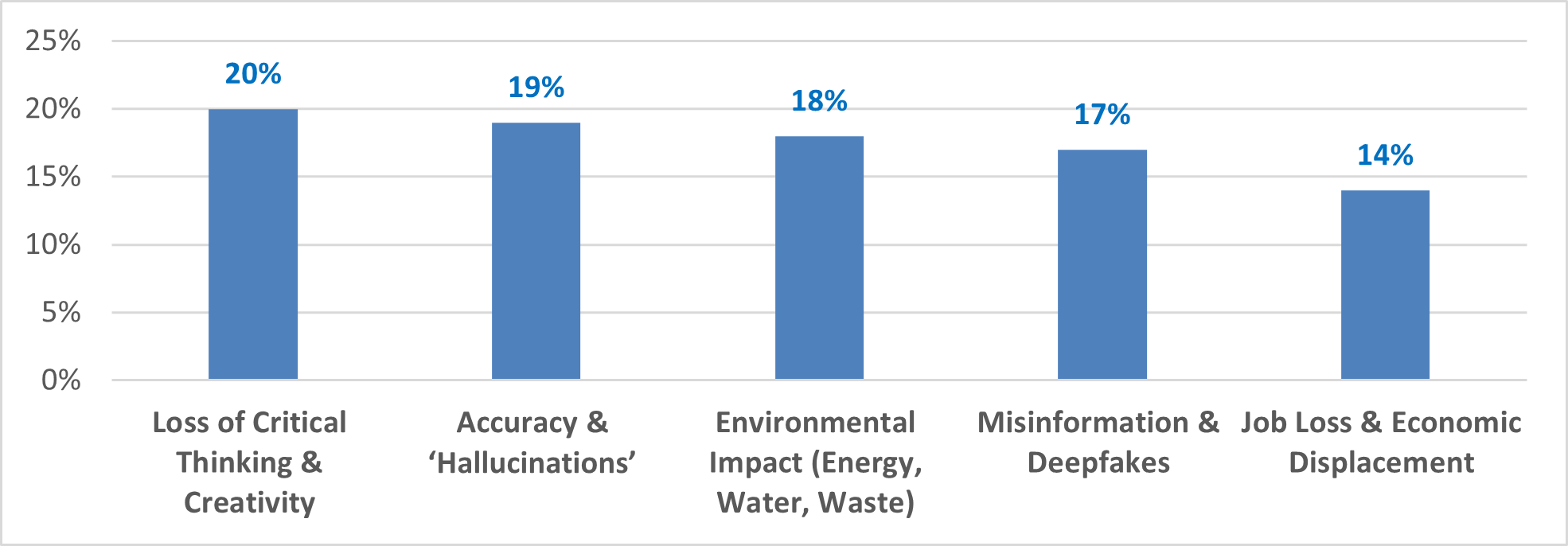
Source: Roy Morgan Snap SMS Survey: October 2-4, 2025. Base: Australians 18+, n= 2,568 total open ended responses.
Australians who say personally, AI creates more problems than it solves highlight accuracy issues, job threats and misinformation as key concerns
1. Accuracy & Reliability Issues (22%)
Australians often describe AI as useful but unreliable, producing errors, fabrications, and answers that require verification.
- “When I used AI for some chemistry problems it gave me wrong answers.”
- “Garbage in, garbage out.”
- “It’s like a trainee office junior I have to check everything.”
2. Job Threats & Cheapening of Human Work (18%)
Creatives and professionals feel AI undervalues human effort and threatens future employment.
- “Cheapening of artwork and higher amounts of AI slop.”
- “It undermines the value of human labour.”
- “Well I used to be a graphic designer and AI would be a huge threat to this industry.”
3. Misinformation, Scams & Deepfakes (15%)
Respondents worry about fake content, deception, and malicious use harming individuals and society.
- “Children bullied or blackmailed because of AI photos.”
- “The unmonitored nature of it.”
- “People get hurt by AI scams.”
4. Dependency & Laziness (11%)
Some believe AI erodes skills and motivation, making life easier but people weaker.
- “AI makes me lazier and unmotivated.”
- “It cheapens thinking people just copy answers.”
- “It’s useful but stops me learning properly.”
5. Privacy & Surveillance Risks (10%)
Many mention data collection, tracking, and future misuse by corporations or governments.
- “It will be used for control.”
- “I’m not worth hacking yet, but the risk is there.”
- “Corporate responsibility!!!”
Top 5 reasons when asked: What makes you agree that for you personally, AI creates more problems than it solves?”
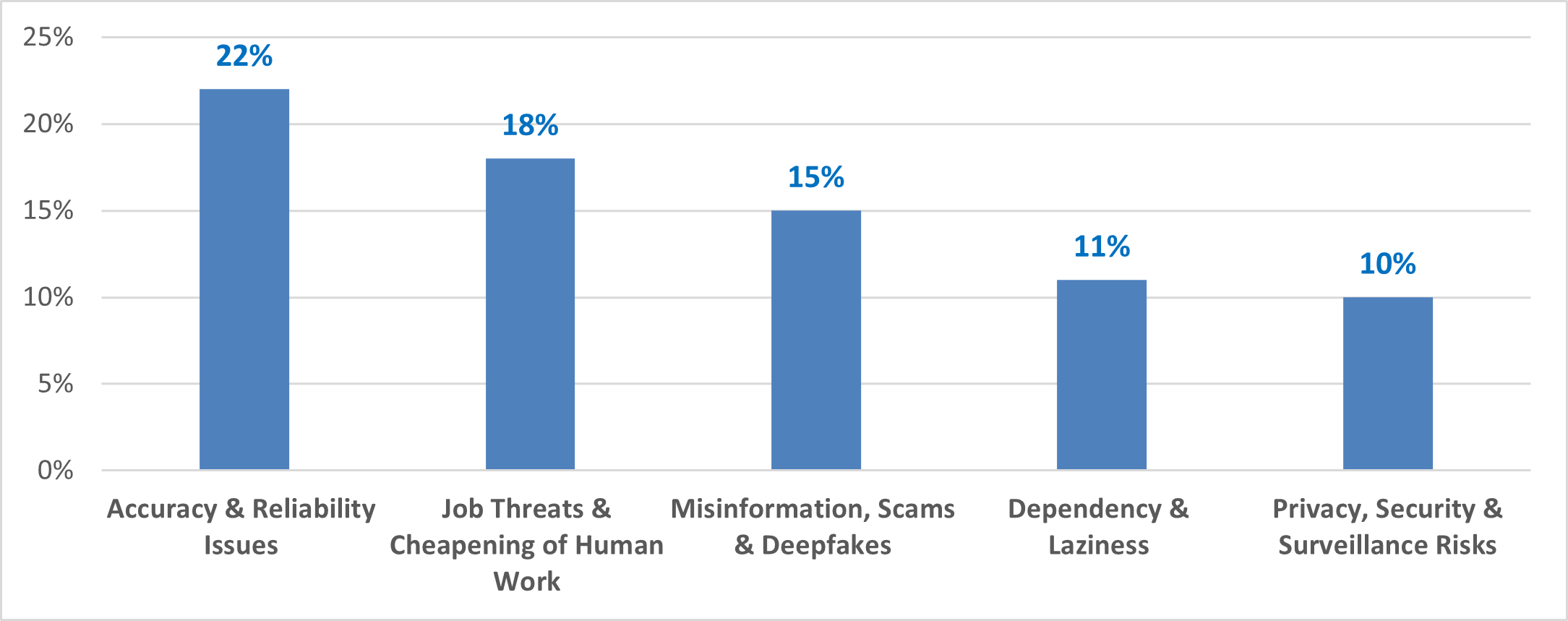
Source: Roy Morgan Snap SMS Survey: October 2-4, 2025. Base: Australians 18+, n= 2,568 total open-ended responses.
Australians who personally say AI solves more problems point to work automation, productivity and information access as key benefits
1. Work Automation & Task Support (49%)
AI is praised for simplifying work, automating routine processes, and acting as a capable assistant across jobs and industries.
People see it as a powerful enabler for professionals, especially in IT, admin, creative, and technical fields.
- “AI helps me solve problems and improve my productivity.”
- “I am a technician so AI is a very effective tool for me. It can decipher multiple manuals and deliver fault finding immediately.”
- “It frees me from menial tasks so I can focus on higher-level work.”
2. Productivity & Efficiency (18%)
Respondents repeatedly link AI to speed, convenience, and time-saving benefits in both work and daily life.
- “It saves me significant research time and ensures nothing falls through the cracks.”
- “AI makes my work life so efficient.”
- “It helps me work smarter, not harder.”
3. Research & Information Access (13%)
A large share use AI for quick information retrieval, learning, and summarisation. It’s seen as faster, clearer, and more useful than traditional search.
- “AI makes it easy to find and distil vast quantities of research.”
- “It helps me collate and filter through data quickly.”
- “I use it for research, and it generates information in seconds.”
4. Creative & Design Support (9%)
Users describe AI as enhancing creativity and helping visualise or prototype ideas.
- “I can create mock-up images before starting a project.”
- “It adds value to my work and personal life through creativity.”
- “AI has helped me as an artist, I spend less time researching and more time doing.”
5. Healthcare & Science Optimism (7%)
Many respondents cite AI’s breakthroughs in medicine and research as proof of its positive impact on humanity.
- “AI has made life-saving advances in the medical world.”
- “It just might save my life from advances in diagnosis.”
- “The potential for solving societal problems is immense, particularly in healthcare.”
Top 5 reasons when asked: What makes you agree that, for you personally, AI solves more problems than it creates?”
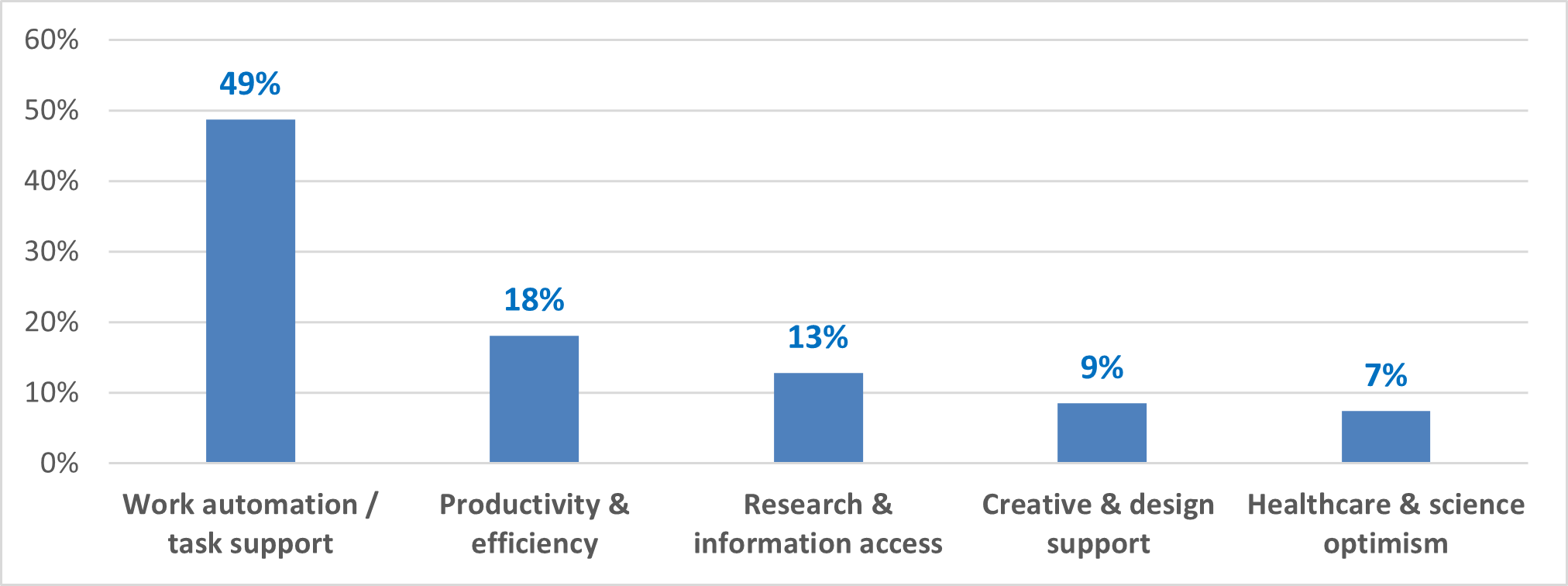
Source: Roy Morgan Snap SMS Survey: October 2-4, 2025. Base: Australians 18+, n= 2,568 total open ended responses.
Roy Morgan CEO Michele Levine says:

“Artificial intelligence is reshaping our world faster than most Australians ever imagined, and that rapid change is fuelling both excitement and unease. The latest data from Roy Morgan shows that 65% of Australians believe AI creates more problems than it solves, up 8% points since 2023. Women (69%) are more sceptical than men (61%).
“What’s particularly revealing is that when people are asked to think personally rather than abstractly, their views soften. Many see direct benefits in productivity, learning and access to knowledge, yet even then, a clear majority of 69% still feel AI creates more problems than it solves. That gap between optimism and anxiety highlights a national tension: Australians are eager to harness the power of AI but remain deeply aware that its success depends on trust, transparency and human oversight.
“A surprising one in four (25%) Australians now see artificial intelligence as a potential existential risk within twenty years, up 5% points since 2023. This shift highlights growing public awareness that the future of AI is not just a technological question but a moral and societal one.”
Australians surveyed were asked the following questions:
Question 1: "Do you agree or disagree that 'Overall, artificial intelligence (AI) creates more problems than it solves?" (50% of sample) or its inverse "Do you agree or -disagree that 'Overall, artificial intelligence (AI) solves more problems than it creates'?"
Question 2: “What makes you Agree/Disagree that "Overall, artificial intelligence (AI) solves more problems than it creates/creates more problems than it solves"?
Question 3: For you personally, do you agree or disagree that, artificial intelligence (AI) creates more problems than it solves? (50% of sample) or its inverse “For you personally, do you agree or disagree that, artificial intelligence (AI) solves more problems than it creates?”
Question 4: “What makes you Agree/Disagree that for you personally, artificial intelligence (AI) solves more problems than it creates? (50% of sample) its inverse
Question 5: “Do you believe artificial intelligence (AI) presents a risk of human extinction in the next two decades?”
For comments or more information about Roy Morgan’s data please contact Andrew Calvert-Jones or Julian McCrann for more details.
Reports available for sale:
The latest Roy Morgan data is available on the Roy Morgan Online Store. It provides demographic breakdowns for Age, Sex, State, Region (Capital Cities/ Country), Generations, Lifecycle, Socio-Economic Scale, Work Status, Occupation, Home Ownership, Voting Intention, Roy Morgan Value Segments, Helix Personas, Media Consumption, and more.
Related Research:
About Roy Morgan
Roy Morgan is Australia’s largest independent Australian research company, with offices in each state, as well as in the U.S. and U.K. A full-service research organisation, Roy Morgan has over 80 years’ experience collecting objective, independent information on consumers.
Margin of Error
The margin of error to be allowed for in any estimate depends mainly on the number of interviews on which it is based. Margin of error gives indications of the likely range within which estimates would be 95% likely to fall, expressed as the number of percentage points above or below the actual estimate. Allowance for design effects (such as stratification and weighting) should be made as appropriate.
| Sample Size | Percentage Estimate |
| 40% – 60% | 25% or 75% | 10% or 90% | 5% or 95% | |
| 1,000 | ±3.0 | ±2.7 | ±1.9 | ±1.3 |
| 5,000 | ±1.4 | ±1.2 | ±0.8 | ±0.6 |
| 7,500 | ±1.1 | ±1.0 | ±0.7 | ±0.5 |
| 10,000 | ±1.0 | ±0.9 | ±0.6 | ±0.4 |
| 20,000 | ±0.7 | ±0.6 | ±0.4 | ±0.3 |
| 50,000 | ±0.4 | ±0.4 | ±0.3 | ±0.2 |



